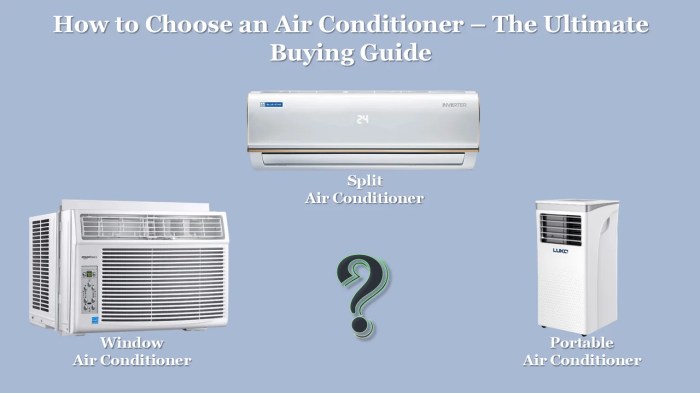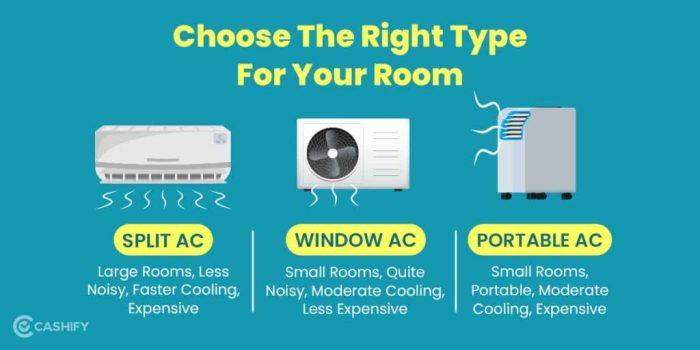Delving into the world of air conditioners tailored for humid climates, this guide offers a comprehensive look at the essential factors, types, sizing, dehumidification features, and maintenance tips to keep you cool and comfortable. Get ready to explore the nuances of choosing the perfect air conditioner for your humid environment.
Factors to Consider
When choosing an air conditioner for a humid climate, there are several key factors to keep in mind to ensure optimal performance and efficiency.
Impact of Humidity on Air Conditioning Systems
High humidity levels can make it harder for air conditioning systems to effectively cool the air. The moisture in the air can make it feel warmer than it actually is, leading to discomfort and the need for more energy to maintain a comfortable temperature indoors.
Key Features to Look For
- Dehumidification Function: Look for an air conditioner with a dehumidification feature to help remove excess moisture from the air, making it feel cooler and more comfortable.
- Variable Speed Compressor: Opt for a unit with a variable speed compressor that can adjust its speed based on the humidity levels, providing more precise cooling and reducing energy consumption.
- High Energy Efficiency Rating: Choose an air conditioner with a high Energy Efficiency Ratio (EER) or Seasonal Energy Efficiency Ratio (SEER) to ensure cost-effective operation in humid climates.
- Programmable Thermostat: A programmable thermostat allows you to set specific humidity levels and temperature settings, helping you maintain a comfortable indoor environment while saving energy.
Importance of Energy Efficiency
In humid climates, where air conditioners may need to run for extended periods to combat high humidity levels, energy efficiency becomes crucial. An energy-efficient unit not only helps lower electricity bills but also reduces the environmental impact of cooling your home.
Look for air conditioners with ENERGY STAR certification for the most efficient models on the market.
Types of Air Conditioners
In humid climates, choosing the right type of air conditioner is crucial for effectively managing indoor humidity levels. Let's explore the different types of air conditioners and their suitability for humid environments.
Central Air Conditioning
Central air conditioning systems are ideal for homes with existing ductwork. They provide consistent cooling throughout the entire house, including dehumidification. However, the installation process can be complex and costly, requiring professional help to ensure proper sizing and placement.
Ductless Mini-Split Systems
Ductless mini-split systems are versatile and efficient options for homes without ductwork. They offer zoned cooling, allowing you to control individual room temperatures and reduce energy waste. These units also provide excellent dehumidification, making them a great choice for humid climates.
Installation is relatively easier compared to central AC but still requires professional assistance.
Portable Air Conditioners
Portable air conditioners are a convenient option for cooling specific areas or rooms. While they are easy to install and move around, they may not be as effective in dehumidifying larger spaces compared to central or ductless systems. These units require proper ventilation and drainage to prevent moisture buildup, especially in humid climates.Overall, the choice of air conditioner type in a humid climate should consider factors like installation requirements, dehumidification capabilities, energy efficiency, and cost.
Each type has its own set of pros and cons, so it's essential to evaluate your specific needs and budget before making a decision.
Sizing and Capacity

Determining the appropriate size and capacity of an air conditioner for a humid climate is crucial to ensure optimal comfort and efficiency in your space. Proper sizing not only helps in effectively removing moisture from the air but also ensures that the unit operates efficiently without being overworked.
Calculating Cooling Capacity
When calculating the cooling capacity needed for a specific space in humid conditions, you need to consider the square footage of the area you want to cool. The cooling capacity of an air conditioner is measured in British Thermal Units (BTUs) per hour.
To determine the required BTUs for your space, you can use the following formula:
BTUs = (Square footage of the room) x 25
This formula provides a general guideline for estimating the cooling capacity needed for a room, but it's essential to take into account other factors such as ceiling height, insulation, and the number of windows in the space. For larger spaces or rooms with high ceilings, you may need to adjust the BTU calculation accordingly to ensure adequate cooling.It's important to note that undersizing your air conditioner can lead to inefficiency and inadequate cooling, while oversizing can result in short cycling, where the unit turns on and off frequently, leading to increased energy consumption and reduced comfort.
By accurately calculating the cooling capacity required for your space, you can ensure that your air conditioner operates efficiently and effectively in humid conditions.
Dehumidification Features
Dealing with high humidity levels can be a challenge, especially in humid climates. Air conditioners with dehumidification features play a crucial role in maintaining a comfortable indoor environment by reducing excess moisture in the air
Types of Dehumidification Technologies
- Refrigeration-Based Dehumidification: This common technology works by cooling the air to condense moisture, which is then collected and drained out of the unit.
- Desiccant Dehumidification: In this method, a desiccant material absorbs moisture from the air, removing humidity effectively.
- Heat Pump Dehumidification: This technology uses a heat pump to remove moisture from the air, improving dehumidification efficiency.
Each technology has its own strengths and is suitable for different humidity levels and room sizes.
Benefits of Dehumidification Features
- Improved Comfort: By reducing humidity levels, dehumidification features help create a more comfortable indoor environment, especially during hot and humid weather.
- Prevention of Mold and Mildew Growth: Excess moisture can lead to mold and mildew growth, which can be harmful to health. Dehumidification helps prevent these issues.
- Better Air Quality: Removing excess moisture from the air can also improve air quality by reducing allergens and pollutants that thrive in humid conditions.
Overall, dehumidification features in air conditioners are essential for maintaining a healthy and comfortable living space in humid climates.
Maintenance and Care
Proper maintenance and care are crucial for ensuring your air conditioner functions efficiently in humid climates. Neglecting maintenance can lead to decreased performance and potential issues like mold growth.
Maintenance Schedule
- Regularly clean or replace air filters every 1-2 months to prevent dust and debris buildup.
- Inspect and clean the evaporator and condenser coils annually to maintain optimal cooling efficiency.
- Check and clear the condensate drain line to prevent clogs that can lead to water leakage and mold growth.
- Ensure the outdoor unit is free from debris and vegetation to allow proper airflow.
Preventing Mold and Mildew Growth
- Keep humidity levels in check by using a dehumidifier or running the air conditioner on a regular basis.
- Ensure proper ventilation in the room to prevent moisture buildup that can promote mold and mildew growth.
- Consider using an air purifier with a mold and mildew filter to improve air quality and prevent spores from circulating.
- If you notice any signs of mold or mildew, such as a musty smell or visible growth, address it promptly to prevent it from spreading.
Impact of Regular Maintenance
Regular maintenance not only extends the lifespan of your air conditioner but also enhances its performance in humid conditions. By following a maintenance schedule and taking preventive measures, you can ensure that your air conditioner operates efficiently and effectively, providing you with cool, dehumidified air when you need it most.
Concluding Remarks

As we conclude this guide on air conditioner buying for humid climates, remember that finding the right unit is crucial for optimal comfort and efficiency. By considering factors like humidity impact, types of air conditioners, sizing, dehumidification features, and maintenance, you can make a well-informed decision to create a cool oasis in even the most humid conditions.
Stay cool and enjoy the comfort of your perfectly suited air conditioner.
Essential Questionnaire
What impact does humidity have on air conditioning systems?
Humidity can make air feel warmer, leading to increased strain on the air conditioner to cool the space effectively. It can also promote mold and mildew growth if not properly managed.
What are the key features to look for in an air conditioner for humid climates?
Look for dehumidification capabilities, energy efficiency ratings, appropriate sizing for your space, and easy maintenance features to ensure optimal performance in humid conditions.
How do you determine the appropriate size and capacity of an air conditioner for a humid climate?
Calculate the cooling capacity needed based on the square footage of the space, taking into account factors like insulation, ceiling height, and sun exposure to ensure efficient cooling in humid conditions.













